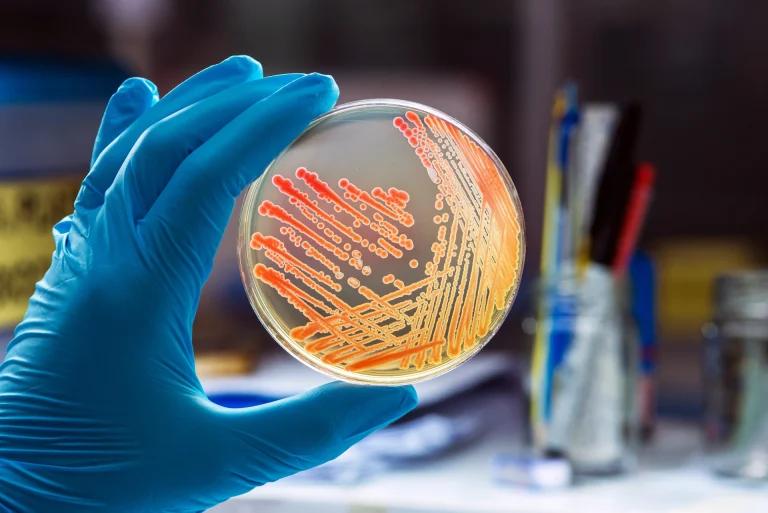You might have heard of Strep throat before, it’s a contagious bacterial infection that causes fever and sore throat. Strep throat is caused by a type of bacteria called Group A Streptococcus bacteria, also called Strep A which is commonly found in the throat and skin.
In rare cases Strep A bacterial infections can lead to pneumonia, meningitis, sepsis and other health complications. Recently in the UK, there have been several deaths in children due to Strep A infections. Microbiologists believe this may be due to a reduced mixing among kids over recent years due to the COVID pandemic, which leads them more susceptible when they come into contact with someone else who is infected. It is extremely rare, but if not treated quickly, Strep A can be fatal.
In this blog post, we’re going to focus on the symptoms of Strep to look out for and how it can be treated. Keep reading to find out more.
What is Strep A?
Streptococcus pyogenes or Group A Streptococcus (GAS), is the most common type of Strep bacteria. Strep A is a bacteria that can cause a sore throat and other health problems. Although it is most commonly associated with throat infections, Strep A can also cause skin infections, such as impetigo or cellulitis. The symptoms of a Strep A infection depend on the type of infection. Throat infections typically cause sore throat, fever and enlarged lymph nodes. Skin infections usually cause redness, swelling and pain.
How are Strep infections spread?
It is spread through close contact with someone who is infected, such as through sneezing or coughing. In addition, it can also spread through direct contact with an infected person, such as through kissing or sharing utensils. If you think you may have come into contact with someone who has a streptococcal infection, it is important to see a doctor as soon as possible.
What are the symptoms of Group A Streptococcal infection?
The symptoms of Strep A can vary depending on how old you are. In young children, the most common symptom is a high fever. Other symptoms can include sore throat, abscesses around the tonsils, red and swollen tonsils, sometimes with white patches or streaks of pus, headache, nausea and vomiting. In school-age children, the most common symptom is a sore throat. Other symptoms can include fever, headache, nausea and vomiting. Strep-A can present in children as Scarlet fever.
Scarlet fever is more common in children. Symptoms of Scarlet fever: a rash typically appears 12 to 48 hours after infection. The rash looks like small, raised bumps and starts on the chest and tummy, then spreads. On lighter skin, the rash looks pink or red. On darker skin, it is harder to see but you can still feel it. The skin almost feels like sandpaper. The rash does not appear on the face, but the cheeks may be red and flushed. The tongue initially is coated white with protruding red bumps. The coating gives way and leaves the tongue red, swollen and covered in small bumps. This can be described as “strawberry tongue”.
For adults, the most common symptoms include a sore throat, high temperature, headache and rash. They might also experience nausea, vomiting and stomach pain. It’s also not uncommon for your lymph nodes to swell up.
The severity of the symptoms can also vary depending on the individual. Some people may only have mild symptoms, while others may experience more severe symptoms. If you think you or your child may have Strep A, it is important to see a doctor for a diagnosis and treatment. Early diagnosis and treatment are essential for preventing serious complications. That leads us to our next question…
How is Strep A diagnosed?
If your doctor suspects that you may have strep throat, they will likely perform a rapid strep test. This is a quick and easy test that can be done right away and only takes a few minutes. During the test, the doctor will swab your tonsils and the back of the throat and then send the sample off to a lab for throat culture testing. If the results come back positive for Strep, i.e. streptococci bacteria has grown, then you will be prescribed antibiotics right away. It is important to note that these tests often report a 25% false negative result, due to incorrect swab collection, or too few bacteria uptake for an accurate sample. If the test is negative, but your doctor still suspects Strep, they may do a culture test which takes longer but is more accurate.
How is Strep A treated?
Once you’ve been diagnosed with Strep throat, it’s important to start treatment right away so you can get rid of the infection quickly and prevent any complications. The good news is that Strep throat is easily treatable with antibiotics. In some cases, your doctor may also prescribe medication to help ease your pain and swelling. If you have scarlet fever, they might also give you an antiseptic cream or lotion to help control the itchiness and rashes.
Most people start feeling better within 48 hours of starting antibiotic treatment, but it’s important to finish the entire course of antibiotics even if you start feeling better, so that all of the bacteria are killed off and there is no risk of further infection or complications down the road. Some common antibiotics used to treat a Strep throat infection include penicillin or amoxicillin. If you’re allergic to those antibiotics, don’t worry—there are other options available too. Just be sure to tell your doctor about any allergies before starting treatment.
In addition to antibiotics, there are also some things you can do at home to ease your symptoms while you wait for the infection to clear up completely. These home remedies include:
- Gargle with warm salt water several times per day
- Drinking lots of fluids
- Suck on lozenges
- Taking over-the-counter pain relievers like ibuprofen or acetaminophen
- Avoiding irritants like alcohol or smoke
- Getting plenty of rest
- Eat soft foods
It’s important that you take your medication as prescribed and finish the entire course even if you start feeling better before it’s done. This helps prevent the infection from coming back and getting stronger. If you stop taking your medication too early, there’s a chance that the infection could come back and that it could be resistant to antibiotics which means it would be much harder to treat.
Who is at most risk of Strep A infections?
Although anyone can get a Strep A infection, certain groups of people are more likely to develop serious complications from the infection. These groups include infants, children under the age of five, people over the age of 65, those with weakened immune systems and chronic diseases and those who have recently been infected with chickenpox.
How to protect others around you from Strep A?
If you find out you have Strep A, it’s essential to take appropriate steps to protect others around you from catching the infection. Firstly, make sure you maintain good personal hygiene. This includes washing your hands regularly with soap and water, particularly after coughing or sneezing and before preparing food.
It’s also advisable to sneeze or cough into a tissue or your elbow instead of your hands. While recovering, avoid close contact with others, particularly with young children, elderly individuals, or those with weakened immune systems, as they may be more susceptible to the infection.
When you are feeling unwell, stay home from nursery, work or school until you have been on antibiotics for at least 24 hours to prevent the spread of the bacteria to others. Don’t forget to replace your toothbrush after starting the antibiotics to ensure you aren’t re-introducing the infection. Lastly, if you have been in contact with someone who has Strep A, be vigilant for symptoms and seek medical advice if you suspect you may have contracted the infection.
What are the complications of strep A?
While most GAS infections are relatively harmless, a small percentage of strains are classified as “invasive” due to their ability to spread through the bloodstream and cause serious illness. Invasive group A Strep (iGAS) infections are relatively rare, but they can be very dangerous, particularly for young children and people with weakened immune systems.
iGAS infections occur when the bacteria enter the bloodstream and begin to multiply. It invades the body through breaks in the skin or mucous membranes. iGAS infections can be difficult to treat because they can spread quickly and are often resistant to antibiotics. Once in the bloodstream, the bacteria can travel to other parts of the body
iGAS infections can be much more serious and may even require hospitalisation. The most common type of iGAS infection is Streptococcal toxic shock syndrome (STSS), which can cause organ failure and death. Other potentially serious iGAS infections include flesh-eating disease (necrotizing fasciitis), rheumatic fever, and a kidney disease called glomerulonephritis. Anyone who develops symptoms of an iGAS infection should seek medical attention immediately.
Seek help from healthcare professionals
If you have any of the symptoms listed in this blog post, it’s important to see a healthcare professional right away so you can get treatment. With prompt treatment, most people recover from Strep A without any complications. However, it’s still possible to spread the infection while you’re taking antibiotics, which is why it’s important to stay home from work or school until your doctor says it’s okay for you to return. If you have any questions about Strep A or other infections, please contact your healthcare provider.
Sources
- UKHSA update on scarlet fever and invasive group A strep – GOV
- Strep Throat – CDC
- Group A Streptococcus – GOV
Medical Disclaimer
NowPatient has taken all reasonable steps to ensure that all material is factually accurate, complete, and current. However, the knowledge and experience of a qualified healthcare professional should always be sought after instead of using the information on this page. Before taking any drug, you should always speak to your doctor or another qualified healthcare provider.
The information provided here about medications is subject to change and is not meant to include all uses, precautions, warnings, directions, drug interactions, allergic reactions, or negative effects. The absence of warnings or other information for a particular medication does not imply that the medication or medication combination is appropriate for all patients or for all possible purposes.








